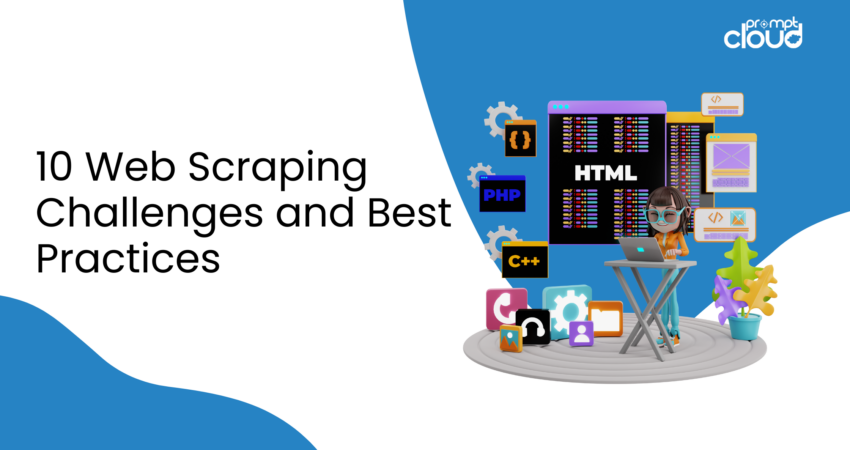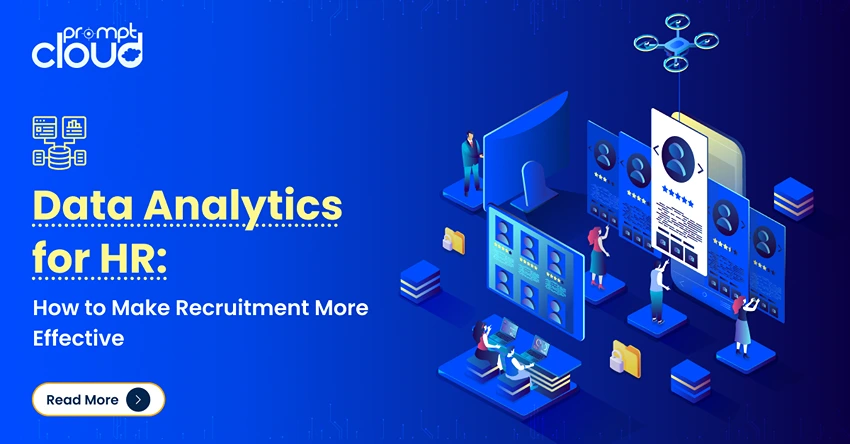
Jimna Jayan
- May 13, 2024
- Blog
Table of Contents
ToggleWeb scraping is a powerful tool for businesses seeking to capture and utilize data to drive strategic decisions. Despite its potential, misconceptions about web scraping or some web scraping challenges can lead to significant missteps. It’s crucial to recognize that web scraping, while legal, requires adherence to ethical standards and respect for copyright laws. Additionally, the quality and utility of the data collected are not guaranteed without proper methodology.
Let’s address some critical myths:
- Myth 1: Web scraping is inherently illegal. In reality, legality depends on how and where you scrape.
- Myth 2: Any data scraped is immediately useful. In fact, data must be carefully validated and cleaned.
- Myth 3: Web scraping is only for tech giants. Businesses of all sizes can benefit from tailored scraping strategies.
Understanding these points is essential as we explore common web scraping challenges. From technical errors to legal challenges, web scraping challenges can compromise your data initiatives. However, with the right approach, these web scraping challenges are not only manageable but can be turned into opportunities for refining your data collection strategy.
Challenges in Web Scraping
1.Ignoring Web Scraping Legal Issues
Web scraping, a potent tool for data collection, operates within a complex web of legal and ethical considerations. Ignoring these web scraping challenges and considerations can lead not only to legal repercussions but can also damage your brand’s reputation.
The legality of web scraping largely hinges on the source website’s terms of service, copyright laws, and various data protection regulations like GDPR in Europe or CCPA in California. Here are key legal areas to consider:
- Copyright Law Typically, the content of a website is copyrighted, and unauthorized use of this data could lead to copyright infringement claims. For example, in 2017, LinkedIn took legal action against a company that scraped millions of user profiles without permission, arguing it violated their terms of service and copyright laws. The case highlighted the importance of respecting the copyright notices and terms of use of websites.
- Terms of Service (ToS) Websites often include clauses in their ToS that explicitly prohibit the automated extraction of their content. Breaching these terms can lead to lawsuits or banned access to the site. For instance, Ryanair successfully sued a company for scraping its site for fare data, which it then used commercially, violating Ryanair’s ToS.
- Data Protection Regulations Laws such as GDPR dictate how personal data should be handled. Scraping personal data without consent can lead to hefty fines. An example here includes the case of a real estate company fined under GDPR for scraping personal data from public directories without user consent, underlining the necessity for compliance with data protection laws.
Best Practices
To navigate the legal and ethical landscape effectively:
- Adhere to the Website’s ToS Always review and comply with the terms of service of the websites you are scraping.
- Limit Data Collection Collect only the data you need and have a legal basis to use, especially when dealing with personal or sensitive information.
- Implement Rate Limiting Respect the website’s infrastructure by limiting the rate of your scraping to avoid causing service disruptions.
- Seek Legal Advice Given the complexities of web scraping laws, consulting with legal experts can help ensure that your data collection methods comply with relevant laws and regulations.
Understanding and respecting these legal and ethical guidelines is essential for conducting responsible and sustainable web scraping practices, ensuring that your activities remain within the bounds of the law and ethical norms.
2. Underestimating Website Structure Changes
In the world of web scraping, some challenges of web scraping are underestimated. Websites often update their layouts, navigation, and content presentation to improve user experience, adhere to new design trends, or enhance security measures. Such changes can break your scraping scripts overnight, leading to incomplete data collection or even complete failures in your scraping operations.
Best Practices
Continuous Monitoring
Regular monitoring of the websites you scrape is crucial. Implementing automated checks that alert you to changes in the website’s HTML structure can help you respond quickly. For instance, you can use tools that specifically detect changes in the CSS selectors, XPaths, or even the overall HTML structure.
Modular Design
When designing your scraping scripts, using a modular approach can save time and resources in the long run. By isolating the parts of your script that directly interact with the website’s HTML from those that handle data cleaning and storage, you can more easily update your scripts in response to changes in the website layout without having to rewrite your entire codebase.
Utilizing Robust Selectors
Choosing the right selectors is key to creating resilient web scraping scripts. Relying solely on specific IDs or XPath that are tightly coupled to the current layout can lead to fragile scrapers. Instead, consider using more robust selectors that are less likely to change.
Leveraging Web Scraping Frameworks
Frameworks like Scrapy or libraries like Beautiful Soup in Python are designed to handle web scraping more effectively. They offer built-in solutions for dealing with dynamic content and can abstract some of the complexities associated with direct HTML interactions.
Building in Redundancies
For critical scraping operations, consider setting up redundant systems with alternative scraping strategies. For example, if the primary method relies on HTML parsing, a secondary system might use API calls (if available) or even different scraping logic that looks at other aspects of the page.
Learning from Changes
Each time a website change disrupts your scraping setup, it’s an opportunity to learn and refine your approach. Analyze why the change impacted your system and whether there were early indicators that could have alerted you sooner. Over time, you’ll develop a more intuitive sense of how different sites tend to evolve.
3. Failing to Manage Scraping Speed
Web scraping is an effective tool for data collection, but it must be executed with consideration for the target website’s resources. Failing to manage the speed of your scraping activities can lead to several issues, including IP bans, server overload, and ultimately, loss of access to valuable data.
Best Practices
Understanding Rate Limiting
Rate limiting is crucial to avoid overwhelming a website’s server, which can cause performance issues for the website and lead to your IP address being blocked. To prevent this, it’s important to understand the limits that websites may have on the frequency of requests from a single user or IP address.
Implementing Delay Mechanisms
To manage the rate of your requests:
- Introduce Delays Use built-in functions in your scraping tool to add delays between requests. For example, tools like Scrapy allow you to customize the download delay setting to control the interval between consecutive requests to the same website.
- Randomize Request Timing To mimic human browsing patterns more closely and avoid detection, randomize the intervals between your requests. This can be more effective than using a fixed delay.
Using Proxy Servers
Proxy servers can help manage scraping speed and avoid IP bans by distributing the requests across multiple IP addresses. Here are a few strategies:
- Rotate IP Addresses Use a pool of proxies to rotate the IP address for each request or after a certain number of requests. This helps in reducing the risk of any single IP getting banned.
- Geographically Diverse Proxies Utilizing proxies from different geographical locations can also help evade geo-specific content blocking or throttling.
Monitoring Server Response
Pay close attention to the response from the server:
- Check for Warnings Some sites might send warnings in their HTTP response headers or through specific pages when you’re making too many requests too quickly. Adjust your request frequency accordingly.
- Adapt to Server Load If you detect slower response times or error codes like 503 (Service Unavailable), it might indicate that the server is under strain. Respect these signals and reduce your request rate.
Respecting Robots.txt
Most websites have a robots.txt file that outlines which parts of the site can be accessed by automated tools. Respecting these guidelines is crucial not only for ethical scraping practices but also for avoiding potential legal issues.
Opting for API Use When Possible
If the target website offers an API with data access, using it can be a more efficient and safer method than scraping web pages. APIs are designed to handle requests and can provide the data in a more structured format, reducing the need to overload the website’s server.
4. Overlooking Data Quality
Data quality is paramount in web scraping; neglecting it can lead to significant inaccuracies that may compromise decision-making and analytical processes. Ensuring the accuracy and reliability of scraped data is not just about collecting it but also about verifying its integrity and relevance.
Best Practices
Implement Validation Checks
Validation is crucial for ensuring the data you scrape is accurate and useful. Implement checks to verify that the data matches expected formats and values. For example:
- Type Checking Ensure that numeric data does not inadvertently contain text, and that dates are in the correct format.
- Range Validation Check that numerical values fall within expected ranges, which helps to identify anomalies or errors in data collection.
- Consistency Checks Make sure the data is consistent across different parts of the dataset. For instance, if you’re scraping product information, ensure that similar products have data presented in a consistent format.
Regular Audits and Updates
Web data can change frequently. Regular audits of your scraping scripts and the data they collect can help you catch any issues that arise from changes in the source website’s structure or content.
- Schedule Regular Reviews Periodically review both the data and the code that collects it to ensure everything is functioning as expected.
- Update Scripts Accordingly When a website updates its layout, your scraping scripts may need to be adjusted to align with these changes, ensuring continued data accuracy.
Handling Incomplete Data
Data gaps can skew analysis and lead to incorrect conclusions. It’s essential to handle incomplete datasets carefully:
- Identify Missing Values: Use tools to systematically check for and report missing data.
- Decide on Handling Methods Depending on the nature of your analysis, decide whether to impute missing values, exclude incomplete records, or note them as limitations in your data analysis.
Cleaning Scraped Data
Data cleaning is a critical step that should not be overlooked. This process involves removing duplicates, correcting errors, and standardizing data formats.
- Normalize Text Data Convert text to a uniform case, remove extra spaces, or standardize formats (e.g., dates and times) to ensure consistency across your dataset.
- Remove Duplicates Ensure that your data does not contain duplicates, which can distort analysis, by implementing checks to identify and remove them.
5. Handling Pagination and Navigation Incorrectly
When scraping data from websites, one often encounters pagination and complex navigation structures that can complicate data collection. Incorrect handling of these elements can lead to incomplete datasets or redundant data extraction, which undermines the efficiency and accuracy of your scraping operation.
Best Practices
Understanding Website Pagination
The first step in managing pagination is to understand how the website implements it. Pagination can be handled in several ways:
- Traditional Pagination This involves navigating through numbered pages typically accessible via “next” and “previous” buttons.
- Infinite Scrolling Some sites load more content as you scroll down, which can be trickier to handle programmatically.
- Dynamic AJAX Requests Websites may use AJAX to load new data without reloading the page, often observed with filters and search results.
Each type of pagination requires a different approach to ensure complete and efficient data collection.
Automated Pagination Handling
Once you understand the pagination mechanism, you can implement automated strategies to navigate through pages:
- Link Extraction for Numbered Pages For traditional pagination, extract links to all pages in advance or dynamically click through using “next” buttons.
- Scroll Simulation for Infinite Pages Tools like Selenium or Puppeteer can simulate user actions like scrolling to trigger data loading on sites with infinite scrolling.
- API Calls for AJAX-Based Pagination If the website uses AJAX, inspect network requests to identify the API calls for data loading, and mimic these directly to retrieve data.
Sequential and Parallel Processing
When handling multiple pages, consider the most efficient way to process them:
- Sequential Processing This involves scraping pages one after another. It’s straightforward but can be time-consuming, especially with a large number of pages.
- Parallel Processing Using multi-threading or asynchronous requests to scrape multiple pages at once can significantly speed up data collection but requires careful handling to avoid overloading the website’s server or getting blocked.
Error Handling in Navigation
Proper error handling is crucial when navigating multiple pages:
- Detect and Retry Failed Requests Implement logic to detect failed requests or incomplete data loads and retry them before moving to the next page.
- Log Errors for Analysis Keep detailed logs of where and why failures occur, which can help refine the scraping process and troubleshoot issues.
6. Not Planning for Data Scalability
Data scalability is a critical aspect of web scraping that often gets overlooked in the initial stages of setting up a scraping operation. As your data needs grow, so does the complexity of managing, storing, and processing the data. Without proper planning, you might find your system slow, unresponsive, or incapable of handling increased loads effectively.
Best Practices
Efficient Data Storage
Choosing the right storage solution is paramount as data volume grows. Consider these options based on your needs:
- Relational Databases: Suitable for structured data with complex queries, like MySQL or PostgreSQL.
- NoSQL Databases Better for semi-structured data or when you need high throughput and flexibility, such as MongoDB or Cassandra.
- Cloud Storage Solutions Services like Amazon S3, Google Cloud Storage, or Azure Blob Storage offer scalable and secure data storage solutions that can handle vast amounts of data.
Implement Data Warehousing
For extensive data analysis and querying, setting up a data warehouse can be beneficial. Data warehouses are designed to handle large volumes of data and support complex analytical queries efficiently. They also allow for historical data analysis, which is beneficial for trend analysis and predictive modeling.
- ETL Processes Establish robust ETL (Extract, Transform, Load) processes to move scraped data into the data warehouse while ensuring data quality and consistency.
Utilize Data Lakes
For unstructured or semi-structured data, consider implementing a data lake architecture:
- Flexibility in Data Formats Data lakes allow you to store data in its native format, which is perfect for data that doesn’t fit neatly into traditional database schemas.
- Scalability and Cost-Effectiveness Data lakes are highly scalable and typically cheaper to expand compared to traditional data storage methods.
Employ Big Data Technologies
As data volume increases, traditional data processing tools might become inadequate. Big data technologies can process large volumes of data efficiently:
- Hadoop A framework that allows for the distributed processing of large data sets across clusters of computers using simple programming models.
- Spark Known for its speed and API simplicity, Spark can handle both batch and real-time data processing.
7. Neglecting Error Handling
Effective error handling is a critical component of any web scraping operation, ensuring the stability and reliability of data collection efforts. Neglecting error handling and related web scraping challenges can lead to incomplete datasets, unnecessary server load, and even cause permanent bans from websites. Implementing robust error-checking and recovery processes not only improves data quality but also enhances the overall resilience of the scraping system.
Best Practices
Anticipate and Identify Common Errors
Before you can handle errors, you must understand what might go wrong. Common errors in web scraping include:
- Connection Errors These occur when your scraper fails to establish a connection with the website, possibly due to network issues or website downtime.
- HTTP Errors These include 404 Not Found, 500 Internal Server Error, and others that the server might return, indicating that something went wrong on the website’s end.
- Timeout Errors When a request takes too long to get a response, it may time out, especially on slower or overloaded websites.
- Data Parsing Errors These occur when changes to the website’s structure make your current scraping setup obsolete.
Implement Retry Mechanisms
A simple and effective error handling strategy is to retry failed requests. Implementing retry mechanisms can help overcome temporary issues like network instability or server errors:
- Exponential Backoff Increase the delay between retries exponentially to reduce the load on the server and increase the chances of a successful request.
- Limit Retries Always set a maximum number of retries to prevent infinite loops and to recognize when an issue might require manual intervention.
Use Robust Parsing Techniques
Robust parsing techniques can prevent or minimize data parsing errors:
- Flexible Selectors Use CSS selectors or XPath expressions that are less likely to break if minor changes occur on the webpage.
- Conditional Checks Before parsing data, check if the elements exist. This can prevent your code from breaking when expected elements are missing.
- Error Logging Capture detailed logs when parsing errors occur. This can help in debugging and improving your parsing strategies.
8. Overlooking Anti-Scraping Technologies
Web scraping often involves overcoming various anti-scraping measures deployed by websites to protect their data. These technologies are designed to block automated systems from accessing content, which can range from simple IP rate limiting to more complex solutions like CAPTCHAs and JavaScript challenges.
Best Practices
Understanding Anti-Scraping Technologies
First, it’s important to identify and understand the types of anti-scraping measures you might encounter:
- CAPTCHAs These are web scraping challenges that distinguish human users from bots, typically requiring users to solve visual puzzles.
- JavaScript Challenges Some sites will use JavaScript to dynamically load content or to execute challenge scripts that must be solved before accessing site data.
- IP Rate Limiting and Blocks Websites may limit the number of requests from a single IP address or block it entirely if suspicious activity is detected.
- User-Agent Verification Sites might require a legitimate user-agent string or block those that are known to belong to bots.
- Cookies and Session Checks Some sites track cookies and session data to ensure that the visitor is maintaining a stateful session.
Strategies to Overcome Anti-Scraping Measures
Here are several approaches to deal with these technologies:
- Rotating Proxies Use a pool of IP addresses to rotate through for each request to avoid IP bans and rate limits. This makes it harder for websites to track scraping activity back to a single source.
- User-Agent Spoofing Regularly rotate user-agent strings in your requests to mimic different browsers and devices. This helps in bypassing blocks that target specific user-agents known to be used by scrapers.
- Handling CAPTCHAs For sites that use CAPTCHA, consider using CAPTCHA-solving services. These services use either human labor or advanced machine learning models to solve CAPTCHAs, and they can be integrated into your scraping workflow.
- Executing JavaScript Use tools like Selenium or Puppeteer that can render JavaScript. This is crucial for scraping websites that load their content dynamically with JavaScript.
- Session Management Maintain and manage cookies and session data to imitate the behavior of a regular user. This can prevent detection by websites that look for session continuity.
Ethical Considerations
While it’s technically possible to bypass many anti-scraping measures, it’s important to consider the ethical implications:
- Respect for Data Privacy and Terms of Service Always ensure that your scraping activities comply with the legal standards and respect the website’s terms of service.
- Minimizing Server Impact Design your scraping strategy to minimize the impact on the website’s resources. Overloading a server can affect the website’s ability to serve its regular users.
9. Inadequate Data Storage and Organization
Effective data storage and organization are crucial for maximizing the utility and accessibility of the data collected through web scraping. Poorly organized data and other related web scraping challenges can lead to inefficiencies, difficulties in data retrieval, and potential errors in data analysis.
Best Practices
Assessing Data Storage Needs
Before selecting a storage solution, it’s important to assess your specific needs:
- Data Volume Estimate the amount of data you’ll be handling. This will influence whether you need a solution capable of handling large-scale data sets effectively.
- Data Structure Determine if your data is structured, semi-structured, or unstructured. This impacts whether a relational database, NoSQL database, or even a file-based system is most appropriate.
- Access Patterns Consider how often and in what ways the data will be accessed. Frequent reads and writes require different optimizations compared to mostly static data repositories.
Choosing Appropriate Storage Solutions
Based on the needs assessment, select a storage solution that best fits the requirements:
- Relational Databases (e.g., MySQL, PostgreSQL): Ideal for structured data with complex query requirements. They offer robust transaction support and powerful query capabilities.
- NoSQL Databases (e.g., MongoDB, Cassandra): Better suited for handling large volumes of semi-structured or unstructured data. They are highly flexible and scale more easily than traditional relational databases.
- Data Warehouses (e.g., Amazon Redshift, Google BigQuery): Designed for complex queries on large data sets, particularly useful for analytics and business intelligence.
- Cloud Storage (e.g., Amazon S3, Google Cloud Storage): Offers scalability and flexibility, making it suitable for storing vast amounts of unstructured data.
Implementing Effective Data Organization
Once the storage is set up, organizing the data effectively is the next critical step:
- Data Modeling Design a schema that logically organizes the data. In relational databases, this involves defining tables, relationships, and indexing strategies. For NoSQL, it might mean designing appropriate document structures.
- Metadata Management Keep metadata to describe and track the nature of the data, including source information, date of acquisition, and any transformations the data has undergone.
- Data Integrity Implement constraints and validation rules to maintain the accuracy and consistency of the data over time.
Automation and Scalability
Automating aspects of data storage and maintenance can enhance scalability and reduce manual overhead:
- Automated Backups: Set up automated processes for backing up data regularly to prevent data loss.
- Scalability Solutions Utilize technologies and architectures that allow your storage solution to grow with your data needs, such as sharding in databases or elastic scalability in cloud services.
10. Failing to Automate and Monitor Scraping Tasks
Automation and monitoring are key components of an efficient web scraping operation, ensuring that the process runs smoothly and continuously delivers high-quality data. Neglecting these web scraping challenges can lead to outdated data, increased errors, and missed opportunities for optimization.
Best Practices
Implementing Automation in Web Scraping
Automation can significantly enhance the efficiency of web scraping by reducing manual intervention and allowing for continuous data collection. Here are some strategies to automate your scraping operations:
- Scheduled Scraping Use task schedulers like cron (Linux) or Task Scheduler (Windows) to run your scraping scripts at regular intervals. This is particularly useful for collecting time-series data or ensuring your data remains up-to-date.
- Workflow Automation Platforms Tools like Apache Airflow, Luigi, or Prefect can help you automate complex workflows, including dependencies between tasks. These platforms allow for more sophisticated error handling, retries, and notifications.
- Cloud-Based Automation Leveraging cloud services such as AWS Lambda, Azure Functions, or Google Cloud Functions can enable you to run scraping tasks at scale without maintaining dedicated servers. These services can trigger scrapes based on time or other events and scale automatically based on demand.
Monitoring Scraping Tasks
Effective monitoring helps ensure that your scraping processes are running as expected and allows you to quickly address any issues that arise. Implement these monitoring strategies:
- Logging Implement comprehensive logging in your scraping scripts. Log important events, errors, and system messages to a file or a monitoring system. Tools like ELK (Elasticsearch, Logstash, Kibana) stack or Splunk can help in analyzing log files more effectively.
- Performance Metrics Track performance metrics such as the number of pages scraped, the duration of scrapes, the success rate of requests, and the amount of data extracted. Monitoring these metrics can help identify performance bottlenecks or inefficiencies in your scraping setup.
- Alerting Set up alerts based on critical errors or performance metrics deviating from expected norms. Services like PagerDuty, Opsgenie, or even simpler solutions like email alerts can be used to notify you when immediate attention is required.
Don’t let these web scraping challenges let you down – embrace these solutions and start scraping smarter today. If you’re seeking more insights or need help with custom web scraping solutions, reach out to our experts at sales@promptcloud.com
Sharing is caring!



















